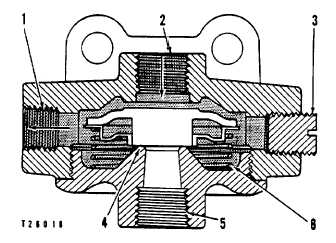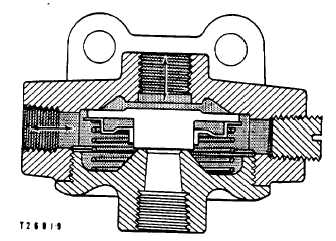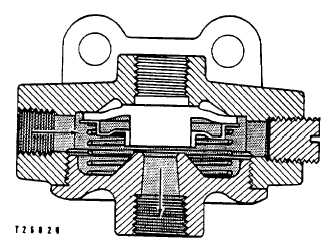TM 5-3825-226-24
out by the master cylinder piston causes the caliper
pistons to extend and apply the brakes. When the apply
force is released, a spring returns the master cylinder
piston and the brake fluid returns to the reservoir.
CAUTION: Always bleed air from the hydraulic brake
system when a line has been disconnected.
Quick Release Valve
The quick release valve releases the air from the
rotochamber. The quick release valve has three
positions. In the OPERATE position, pressure air goes
through the valve into the rotochamber. In the HOLD
position, pressure air is held in the rotochamber. In the
RELEASE position, air in the rotochamber is released
through exhaust passage (5).
When the brake pedal is pushed down, pressure air
goes into the inlet passage (2) of the quick release
valve. The diaphragm (4) moves down, closing the
exhaust passage (5). The outer edges of the diaphragm
are pushed down against the resistance of spring (6).
Pressure air goes through the outlet passage ( 1) to the
rotochamber.
QUICK RELEASE VALVE
(OPERATE POSITION)
1. Passage to rotochamber. 2. Inlet passage. 3.
Plug. 4. Diaphragm. 5. Exhaust passage. 6.
Spring.
When the pressure below the diaphragm is the same
as the pressure above the diaphragm, spring (6) moves
the edge of the diaphragm up against the valve body.
The center of the diaphragm still covers the exhaust
passage (5). This is the HOLD position.
QUICK RELEASE VALVE
(HOLD POSITION)
When the control valve for the service brakes is
released, air pressure on top of the diaphragm is
released. The air pressure in the rotochambers lifts the
diaphragm and opens exhaust passage (5). Air goes out
of the rotochambers through passage (I) to release the
brakes.
QUICK RELEASE VALVE
(EXHAUST POSITION)
Wheel Brakes
The friction pad (3) is pushed against disc (6) to provide
brakes for the machine. The discs turn with the wheel
hubs, and the calipers are connected solidly on the axle
flange. The brake assembly has two pistons and a
friction pad on each side of the disc. The pads and
backing are held in place by anchor pins. When there is
a brake application. oil pushes the piston and pads
against the disc.
CAUTION: To prevent damage to pistons and seals.
do not push on brake pedal when brake pads are
removed.
5-16





